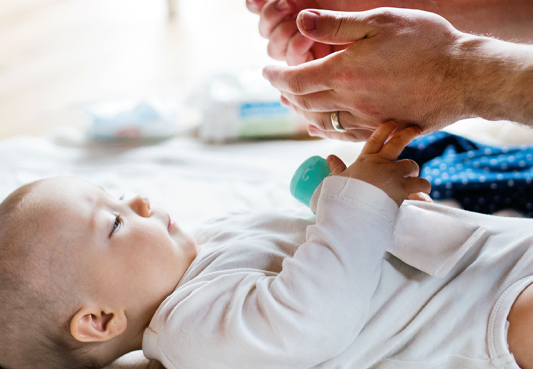Mothers in NYC Continue to Face High Unemployment Rate as Nation’s Recovered
The onset of the COVID-19 pandemic placed an outsized strain on parents as schools and child care centers closed to mitigate the spread of the virus. Nationally, mothers in the workforce experienced a larger increase in unemployment than fathers. While New York City saw a different trend initially, in 2022 the previously strong job gains for women with children slowed compared to their male counterparts (see Figure 1). This brief suggests some of the unevenness of the labor market recovery is due to demographic and industry sector differences and their relationship to a desire for flexible work.
FIGURE 1 – Unemployment Rates for Male and Female Workers with Children in New York City, 2000 to 2022
Sources: U.S. Bureau of Labor Statistics, Current Population Survey; OSC analysis
The unemployment rate for mothers in the City rose more dramatically than it did elsewhere in New York State or nationally. Although there has been substantial improvement in the unemployment rate for mothers citywide, the rate remains higher than for mothers nationally and in the rest of the State. In 2022, women with children nationally faced an unemployment rate of 3.4 percent, lower than in 2019.1 Mothers in the City faced an elevated rate of 5.7 percent, driven in part by a large number who are actively looking for work (see Figure 2). While the number of working mothers and those actively looking for work, which combine to make up the labor force, has risen in the rest of the State and nationwide, it has grown substantially in the City, as some mothers may see an opportunity to leverage new and more flexible working opportunities.
FIGURE 2 – Unemployment and Labor Force Participation Rates for Mothers in the Workforce by Geography
| Unemployment | Labor Force Participation | |||||
|---|---|---|---|---|---|---|
| New York City | Rest of New York State | United States | New York City | Rest of New York State | United States | |
| 2019 | 4.1% | 3.3% | 3.6% | 62.2% | 73.8% | 72.6% |
| 2020 | 12.6% | 7.8% | 7.5% | 60.5% | 72.8% | 71.4% |
| 2021 | 8.0% | 5.4% | 5.1% | 64.0% | 73.2% | 71.3% |
| 2022 | 5.7% | 3.0% | 3.4% | 68.8% | 75.8% | 73.1% |
| Difference, 2019 to 2022 | 1.6 | -0.4 | -0.1 | 6.6 | 2.0 | 0.5 |
Note: Difference refers to percentage points. Numbers are rounded.
Sources: U.S. Bureau of Labor Statistics, Current Population Survey; OSC analysis
Nine Percent of Black Mothers Still Unemployed in 2022
While mothers of all major racial and ethnic groups in New York City saw a decrease in unemployment between 2020 and 2022, Black women with children experienced the largest spike in 2020 to 15.5 percent, which has impacted their recovery. In 2021, unemployment rates for all groups fell, coinciding with the full and more consistent reopening of schools in the City that enabled more mothers to rejoin the workforce (see Figure 3).2 The largest drop in unemployment was for Black mothers in 2021.
FIGURE 3 – Unemployment Rates for Mothers by Race and Ethnicity in New York City
Sources: U.S. Bureau of Labor Statistics, Current Population Survey; OSC analysis
However, as of 2022, 9 percent of Black mothers were still unemployed, virtually unchanged from 2021; nationally, 6.5 percent were still unemployed. Every other major racial and ethnic group of mothers saw a further decline in unemployment in the City in 2022, though the unemployment rate for Hispanic mothers also remained above 6.5 percent. These trends warrant further investigation. As the unemployment gaps between Black and White, and Hispanic and White mothers were present even prior to the onset of the pandemic, these historic differences could remain stagnant or widen if all parts of the local economy do not fully recover.
The dissimilar pace of recovery may be driven by the industry of employment. In 2021 (latest available data), 42.8 percent of Black women with children in the City were employed in the health care and social assistance industry compared to only 31.1 percent nationally.3 The pandemic highlighted the difficult working conditions (i.e., long hours and understaffing) especially among licensed practical nurses and long-term care workers such as home health aides, jobs where Black women are employed at higher rates nationally and citywide. While jobs in the City’s health care industry have grown at a faster pace than in the rest of the nation, it is possible that some mothers appear to be reevaluating their career paths; they are actively seeking work, though perhaps in a different industry. In addition, the number of mothers employed in public administration, which has a larger share of non-White women than other industries, has declined substantially. New York City is the largest local public employer.
Likelihood of Working Mothers Preferring Flexibility Increases
Some mothers in the City appear to be interested in flexible options outside full-time work amounting to 35 hours or more per week. In the City, the number of employed women with children who said they did not want to work full-time surged by 79.4 percent between 2020 and 2022 compared to only a 12.4 percent increase nationally (see Figure 4).
FIGURE 4 – Number of Employed Mothers Stating They Do Not Want Full-Time Work by Geography
| New York City | Rest of New York State | United States | |
|---|---|---|---|
| 2019 | 49,704 | 121,774 | 3,281,003 |
| 2020 | 35,596 | 100,709 | 2,585,440 |
| 2021 | 40,981 | 89,687 | 2,753,287 |
| 2022 | 63,875 | 116,314 | 2,904,998 |
| Percent Change, 2020 to 2022 | 79.4% | 15.5% | 12.4% |
| Percent Change, 2019 to 2022 | 28.5% | -4.5% | -11.5% |
Sources: U.S. Bureau of Labor Statistics, Current Population Survey; OSC analysis
The number of City mothers who preferred another option outside full-time work in 2022 was still larger than in 2019, whereas in the rest of the State and nationally, they fell below pre-pandemic levels. The most common reason for mothers preferring non-full-time work nationally (not enough data are available for the City) was family/personal obligations other than child care (61.6 percent), followed by child care problems (26.8 percent). During the pandemic, mothers nationally not only faced challenges with a lack of child care but also with the rising cost of care centers. Child care issues may have also stunted the ability of mothers in the City to work remotely and care for their children at the same time, as over 22 percent of them worked in industries conducive to remote work including finance and insurance, information, and professional and business services (compared to 17 percent nationally).
As social distancing policies eased and employees returned to the office, some Black and Asian women may have shifted their preference towards self-employment, which may offer additional flexibility to workers. In particular, between 2021 and 2022, the percentage of self-employed Black women in the City rose by over 70 percent. Difficult working conditions may have driven Black women to prefer self-employment over the public or private sectors (see Figure 5; data are limited for women with children generally). Studies have also suggested that biases in the workplace may affect employment outcomes such as promotions or raises for women of color.4 While self-employment can provide flexibility, it has been shown to increase the risk of financial instability and reduce access to traditional employment benefits such as health insurance.5
FIGURE 5 – Women’s Self-Employed Share of Workforce by Race and Ethnicity, 2019 vs. 2022
| New York City | United States | |||||||
|---|---|---|---|---|---|---|---|---|
| White | Black | Asian | Hispanic | White | Black | Asian | Hispanic | |
| 2019 | 10.9% | 4.5% | 4.7% | 7.6% | 8.8% | 4.3% | 7.6% | 5.6% |
| 2022 | 10.9% | 5.4% | 5.2% | 6.6% | 9.1% | 5.1% | 7.7% | 7.0% |
| Difference, 2019 to 2022 | 0.0 | 0.8 | 0.5 | -1.0 | 0.3 | 0.8 | 0.1 | 1.4 |
Note: Difference refers to percentage points. Numbers are rounded.
Sources: U.S. Bureau of Labor Statistics, Current Population Survey; OSC analysis
The self-employed share of Hispanic women declined considerably between 2019 and 2022, though 2022 saw improvement following two years of declines that were not seen nationwide. Self-employment remains most likely among White women. According to the New York City Comptroller’s annual report on Minority/Women-Owned Business Enterprises (M/WBE), women-owned firms lag those owned by men in terms of number and value of registered contracts with the City.6 In addition, among women-owned business enterprises that were awarded contracts, the majority were owned by White women.
Wage Gap Could Mean Sustained Poverty for Women
During the pandemic, wages grew significantly, reaching double-digit annual growth as the number of job openings outpaced that of unemployed people. However, wage growth has slowed from its robust pace from early 2022, suggesting mothers who are actively seeking work are less likely to benefit from recent wage growth. This may further widen the wage gap between women and men (for more information on the wage gap in New York State, see OSC’s report).7 Currently, women still earn less than 82 cents on the dollar for every dollar earned by men.8
This wage gap helps explain why women are also more likely to face poverty than men. In 2021, 55 percent of people living in poverty in New York City were women.9 Men have been shown to be much less likely to experience poverty than women, especially female householders with no spouse present. In the City, 45 percent of Black households were led by a woman with no spouse.
Outlook
Mothers in New York City are experiencing a higher unemployment rate than mothers nationally, with Black women with children facing the greatest challenges driven, in part, by the industry of employment. The high unemployment rate among all mothers in the City suggests they are actively seeking work, which could be complicated by the preference for flexible options outside full-time work. As economic growth slows from its robust pace in 2021, mothers may continue to see an elevated unemployment rate. Mothers and women generally tend to face challenges during periods of economic downturn (i.e., relatively low pay, benefits and savings and lack of spousal support in some cases).
As mothers, and workers citywide, navigate the shifting economic landscape, public assistance has risen to meet the demand for necessities such as food, fuel and shelter. In January 2023, caseloads rose by over 38 percent compared to the same month in 2020. Households headed by Black and Hispanic individuals made up 45 percent and 40 percent, respectively, of those receiving temporary assistance.10
The City and State have recognized the financial and social needs of mothers and families but may be able to do more to enhance outreach on existing services. The Mayor is creating an office to ensure early education and care for children in high-need neighborhoods.11 At the request of the City, the Enacted Budget for State fiscal year 2022-23 included refundable City tax credits (to begin in City fiscal year 2024) for providing new child care seats and establishing child care centers. The State budget also included $7 billion in support for child care over four years, to alleviate affordability concerns. However, as only 10 percent of eligible families accessed those resources, the Governor plans to widen program eligibility. Other programs that have afforded time to take care of family members, such as paid family leave, have also seen increasing use particularly among lower-income individuals.12
The City and State should also continue to encourage employment opportunities to support mothers in the workforce looking for flexibility. These efforts may include enhanced outreach to women-owned firms, particularly those owned by non-White women, to increase their rate of M/WBE certification and improve opportunities for new business. As the risk of an economic downturn remains and job growth slows, elected leaders must continue to monitor labor force and poverty trends and ensure a wide array of opportunities are available for mothers to enter and remain engaged in the labor force.
Related Reports
Endnotes
1 U.S. Bureau of Labor Statistics, Current Population Survey. OSC analyzed annual data aggregated from monthly files of the Current Population Survey.
2 Office of the New York State Comptroller (OSC), New York City’s Uneven Recovery: An Analysis of Labor Force Trends, Report 3-2023, May 2022, https://www.osc.state.ny.us/files/reports/osdc/pdf/report-3-2023.pdf.
3 U.S. Census Bureau, 2021 American Community Survey 1-Year Estimates.
4 Janette Dill and Mignon Duffy, “Structural Racism and Black Women’s Employment in the US Health Care Sector,” Health Affairs, Vol. 41, No. 2, February 2022, https://www.healthaffairs.org/doi/full/10.1377/hlthaff.2021.01400; and The Harris Poll, “State of Inequity 2023: Envisioning a Post-Pandemic Workplace,” February 10, 2023, https://theharrispoll.com/briefs/hue-state-of-inequity-2023-envisioning-a-post-pandemic-workplace/.
5 U.S. Department of Agriculture, “Self-Employed Workers Are Less Likely to Have Health Insurance Than Those Employed by Private Firms, Governments,” Amber Waves, July 5, 2022, https://www.ers.usda.gov/amber-waves/2022/july/self-employed-workers-are-less-likely-to-have-health-insurance-than-those-employed-by-private-firms-governments/.
6 New York City Comptroller, Annual Report on M/WBE Procurement: FY22 Findings and Recommendations, February 2023, https://comptroller.nyc.gov/wp-content/uploads/documents/Annual-Report-on-MWBE-Procurement.pdf.
7 OSC, Despite Progress, Pay Gap for Women Persists, Economic and Policy Insights, March 24, 2022, https://www.osc.state.ny.us/reports/despite-progress-pay-gap-women-persists.
8 U.S. Census Bureau, 2021 American Community Survey 1-year Estimates.
9 Ibid.
10 New York City Department of Social Services, Human Resources Administration; Office of Performance Management and Data Analytics, HRA Program Facts and Reports, https://www.nyc.gov/assets/hra/downloads/pdf/facts/hra_facts/2023/hra_facts_2023_01.pdf.
11 Office of the Mayor of the City of New York, “Mayor Adams Announces Creation of First-ever Mayor’s Office of Child Care and Early Childhood Education,” press release, February 10, 2023, https://www.nyc.gov/office-of-the-mayor/news/105-23/mayor-adams-creation-first-ever-mayor-s-office-child-care-early-childhood; and Office of the City of New York, Accessible, Equitable, High-quality, Affordable: A Blueprint for Child Care and Early Childhood Education in New York City, https://www.nyc.gov/assets/home/downloads/pdf/office-of-the-mayor/2022/Childcare-Plan.pdf.
12 OSC, New York’s Paid Family Leave Program, Economic and Policy Insights, April 23, 2023, https://www.osc.state.ny.us/reports/new-yorks-paid-family-leave-program.





